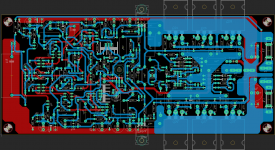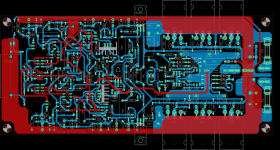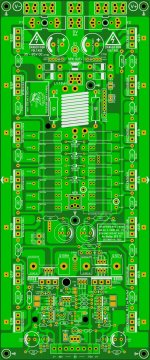Today i have a very-very good news for all of you Slewmaster guys!
I had a personal message from Pete (Ostriber)!!!
He is healthy, corona free!
I hope he will be here again soon. 😎
Well come Boss.
Great news! Looking forward to his return.
Centrlized Data-Storage
hope you all had a very peaceful Christmas without Corona
and best wishes for recovery for all, who were not that lucky.
First of all let me congratulate this team for this excellent project,
second my apology, that I was not aware of it before this Xmas.
I tried to get a complete overview during the last three day and learned,
that there are 3 power-steps of output stages and around 16(!) input stages,
that have been designed, built and tested. Simply great!
But I failed completely to get the background and rational for this efford:
- What was the target of this project?
- Is there another tread, that described the rational?
- Why so many variants? VFA vs CFA?
- What are the key-characteristics, that separate winning concepts from the rest?
- What was the outcome of the project? Which concept was the winner?
Question too early to ask?
If I as a very late-comer needed to make my decision, which concept to select:
what should be my choice?
Lots of Qs, I hope very much to get some helping hand after having clicked through more that 1000 pages with more than 10k postings.
kr, sepp2gl
P.S.: I am going through the spice-simulation-based benchmark project, that I described within my intro. My main focus is Current-Drive vs. Voltage-Drive, but also CFA vs VFA.
I started with writing test-skripts for ngspice, that shall apply for all candidate-amps and generate all needed characteristic metrics.
Now I am going to get it running with an Elektor-Amp called "50W Kleine Qualitätsendstufe", which has a CFA-IPS.
hope you all had a very peaceful Christmas without Corona
and best wishes for recovery for all, who were not that lucky.

First of all let me congratulate this team for this excellent project,
second my apology, that I was not aware of it before this Xmas.
I tried to get a complete overview during the last three day and learned,
that there are 3 power-steps of output stages and around 16(!) input stages,
that have been designed, built and tested. Simply great!
But I failed completely to get the background and rational for this efford:
- What was the target of this project?
- Is there another tread, that described the rational?
- Why so many variants? VFA vs CFA?
- What are the key-characteristics, that separate winning concepts from the rest?
- What was the outcome of the project? Which concept was the winner?
Question too early to ask?
If I as a very late-comer needed to make my decision, which concept to select:
what should be my choice?
Lots of Qs, I hope very much to get some helping hand after having clicked through more that 1000 pages with more than 10k postings.
kr, sepp2gl
P.S.: I am going through the spice-simulation-based benchmark project, that I described within my intro. My main focus is Current-Drive vs. Voltage-Drive, but also CFA vs VFA.
I started with writing test-skripts for ngspice, that shall apply for all candidate-amps and generate all needed characteristic metrics.
Now I am going to get it running with an Elektor-Amp called "50W Kleine Qualitätsendstufe", which has a CFA-IPS.
GreenAmp
Thanks for guiding me further down the road.
I just scanned the GreenAmp thread.
Class-G seems to be a promising technique to reduce power-losses.
If I recall right some Bryston Power-Amps are Class-G..............
Nope, I just looked at the schematic of the Bryston 3B IV Amp, and I have to readjust my assumption: it is more a kind of output-cascode concept (see attached schematic).
Nevertheless, (imho) neither Class-G nor any other efficiency improvement must degrade the amplifier's performance data in terms of THD, IMD, TIM, etc.
Thanks for guiding me further down the road.
I just scanned the GreenAmp thread.
Class-G seems to be a promising technique to reduce power-losses.
If I recall right some Bryston Power-Amps are Class-G..............
Nope, I just looked at the schematic of the Bryston 3B IV Amp, and I have to readjust my assumption: it is more a kind of output-cascode concept (see attached schematic).
Nevertheless, (imho) neither Class-G nor any other efficiency improvement must degrade the amplifier's performance data in terms of THD, IMD, TIM, etc.
What are these IPS-variants?Green amp narrows down the input stage to only two variants !
I wonder, why the other variants have been sorted out.
Again: which one was the winner?
PS.: The Bryston Manual was too big for upload. sorry
Last edited:
PCB style
bimo what about this style PCB I think you can do it with more pairs I've saving this for later, I attached the image as reference maybe this can give you ideas 🙂
bimo what about this style PCB I think you can do it with more pairs I've saving this for later, I attached the image as reference maybe this can give you ideas 🙂
Attachments
Last edited:
What are these IPS-variants?
I wonder, why the other variants have been sorted out.
Again: which one was the winner?
There are two variants - CFA and VFA. It was never about a winner, just the best circuits from both topologies. Some circuits didn't work out as they were unstable.
Last edited:
It isn't a simple question.What are these IPS-variants?
I wonder, why the other variants have been sorted out.
Again: which one was the winner?
PS.: The Bryston Manual was too big for upload. sorry
We haven't the same preference not same source, speakers e. t. c
All IPS(input stages) are tested and results published here.
Unfortunately you must listen yourself some of them.
I haven't golden ears not high end speakers.
Don't expect a final answer.
There are very good Voltage feedback and Current feedback IPS.Choice is your's!
bimo what about this style PCB I think you can do it with more pairs I've saving this for later, I attached the image as reference maybe this can give you ideas 🙂
You can make the pcb layout. The schematic and simulation in my previous post.
bimo I generate the schematic can this work on Slewmaster OPS boards?
No. Because the pre-driver is bootstraped. The value of OITPC compensation is depend on phase shift of the output stage. If you want to use OITPC compensation with slewmaster's OPS, the value shoud be changed.
- Home
- Amplifiers
- Solid State
- Slewmaster - CFA vs. VFA "Rumble"



